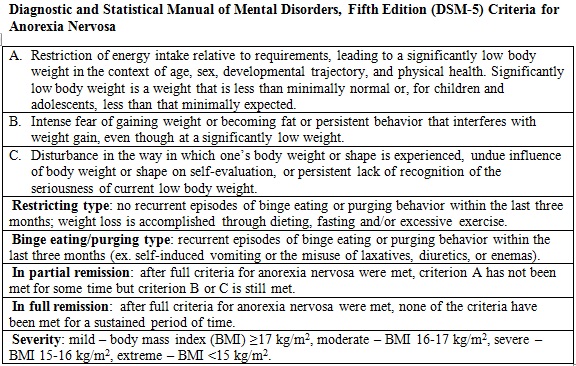[1]
Strand M, von Hausswolff-Juhlin Y, Welch E. [ARFID: food restriction without fear of weight gain]. Lakartidningen. 2018 Sep 11:115():. pii: E97R. Epub 2018 Sep 11
[PubMed PMID: 30226628]
[2]
Phillipou A,Rossell SL,Castle DJ, Anorexia nervosa or starvation? The European journal of neuroscience. 2018 Dec
[PubMed PMID: 30218629]
[3]
Burton AL, Mitchison D, Hay P, Donnelly B, Thornton C, Russell J, Swinbourne J, Basten C, Goldstein M, Touyz S, Abbott MJ. Beliefs about Binge Eating: Psychometric Properties of the Eating Beliefs Questionnaire (EBQ-18) in Eating Disorder, Obese, and Community Samples. Nutrients. 2018 Sep 14:10(9):. doi: 10.3390/nu10091306. Epub 2018 Sep 14
[PubMed PMID: 30223500]
[4]
Gander M, Sevecke K, Buchheim A. Disorder-specific attachment characteristics and experiences of childhood abuse and neglect in adolescents with anorexia nervosa and a major depressive episode. Clinical psychology & psychotherapy. 2018 Nov:25(6):894-906. doi: 10.1002/cpp.2324. Epub 2018 Sep 14
[PubMed PMID: 30216616]
[5]
Zayas LV, Wang SB, Coniglio K, Becker K, Murray HB, Klosterman E, Kay B, Bean P, Weltzin T, Franko DL, Eddy KT, Thomas JJ. Gender differences in eating disorder psychopathology across DSM-5 severity categories of anorexia nervosa and bulimia nervosa. The International journal of eating disorders. 2018 Sep:51(9):1098-1102. doi: 10.1002/eat.22941. Epub 2018 Sep 7
[PubMed PMID: 30193008]
[6]
Levinson CA, Zerwas SC, Brosof LC, Thornton LM, Strober M, Pivarunas B, Crowley JJ, Yilmaz Z, Berrettini WH, Brandt H, Crawford S, Fichter MM, Halmi KA, Johnson C, Kaplan AS, La Via M, Mitchell J, Rotondo A, Woodside DB, Kaye WH, Bulik CM. Associations between dimensions of anorexia nervosa and obsessive-compulsive disorder: An examination of personality and psychological factors in patients with anorexia nervosa. European eating disorders review : the journal of the Eating Disorders Association. 2019 Mar:27(2):161-172. doi: 10.1002/erv.2635. Epub 2018 Aug 22
[PubMed PMID: 30136346]
[7]
Nagata JM, Garber AK, Tabler JL, Murray SB, Bibbins-Domingo K. Prevalence and Correlates of Disordered Eating Behaviors Among Young Adults with Overweight or Obesity. Journal of general internal medicine. 2018 Aug:33(8):1337-1343. doi: 10.1007/s11606-018-4465-z. Epub 2018 Jun 11
[PubMed PMID: 29948810]
[8]
Sacco B, Kelley U. Diagnosis and Evaluation of Eating Disorders in the Pediatric Patient. Pediatric annals. 2018 Jun 1:47(6):e244-e249. doi: 10.3928/19382359-20180523-02. Epub
[PubMed PMID: 29898236]
[9]
Dittmer N, Voderholzer U, von der Mühlen M, Marwitz M, Fumi M, Mönch C, Alexandridis K, Cuntz U, Jacobi C, Schlegl S. Specialized group intervention for compulsive exercise in inpatients with eating disorders: feasibility and preliminary outcomes. Journal of eating disorders. 2018:6():27. doi: 10.1186/s40337-018-0200-8. Epub 2018 Sep 11
[PubMed PMID: 30214803]
Level 2 (mid-level) evidence
[10]
Hale MD, Logomarsino JV. The use of enteral nutrition in the treatment of eating disorders: a systematic review. Eating and weight disorders : EWD. 2019 Apr:24(2):179-198. doi: 10.1007/s40519-018-0572-4. Epub 2018 Sep 8
[PubMed PMID: 30196528]
Level 1 (high-level) evidence
[11]
Lock J, Family therapy for eating disorders in youth: current confusions, advances, and new directions. Current opinion in psychiatry. 2018 Jul 30
[PubMed PMID: 30063479]
Level 3 (low-level) evidence
[12]
Grenon R, Carlucci S, Brugnera A, Schwartze D, Hammond N, Ivanova I, Mcquaid N, Proulx G, Tasca GA. Psychotherapy for eating disorders: A meta-analysis of direct comparisons. Psychotherapy research : journal of the Society for Psychotherapy Research. 2019 Oct:29(7):833-845. doi: 10.1080/10503307.2018.1489162. Epub 2018 Jun 29
[PubMed PMID: 29958509]
Level 1 (high-level) evidence
[13]
Vust S, Cook-Darzens S, Lier F, Ambresin AE. [Adolescents suffering from anorexia nervosa: an evidence-based approach of the parent's role in 2018]. Revue medicale suisse. 2018 Apr 18:14(603):835-838
[PubMed PMID: 29668146]
[14]
Gómez-Candela C, Palma Milla S, Miján-de-la-Torre A, Rodríguez Ortega P, Matía Martín P, Loria Kohen V, Campos Del Portillo R, Martín-Palmero Á, Virgili Casas MªN, Martínez Olmos MÁ, Mories Álvarez MªT, Castro Alija MªJ, Martín-Palmero Á. [Consensus document about the nutritional evaluation and management of eating disorders: anorexia nervosa]. Nutricion hospitalaria. 2018 Mar 7:35(Spec No1):11-48. doi: 10.20960/nh.1561. Epub 2018 Mar 7
[PubMed PMID: 29565628]
Level 3 (low-level) evidence
[15]
Vásquez N, Urrejola P, Vogel M. [An update on inpatient treatment of anorexia nervosa: practical recommendations]. Revista medica de Chile. 2017 May:145(5):650-656. doi: 10.4067/S0034-98872017000500013. Epub
[PubMed PMID: 28898342]
[16]
Ziser K, Mölbert SC, Stuber F, Giel KE, Zipfel S, Junne F. Effectiveness of body image directed interventions in patients with anorexia nervosa: A systematic review. The International journal of eating disorders. 2018 Oct:51(10):1121-1127. doi: 10.1002/eat.22946. Epub 2018 Sep 6
[PubMed PMID: 30189104]
Level 1 (high-level) evidence

